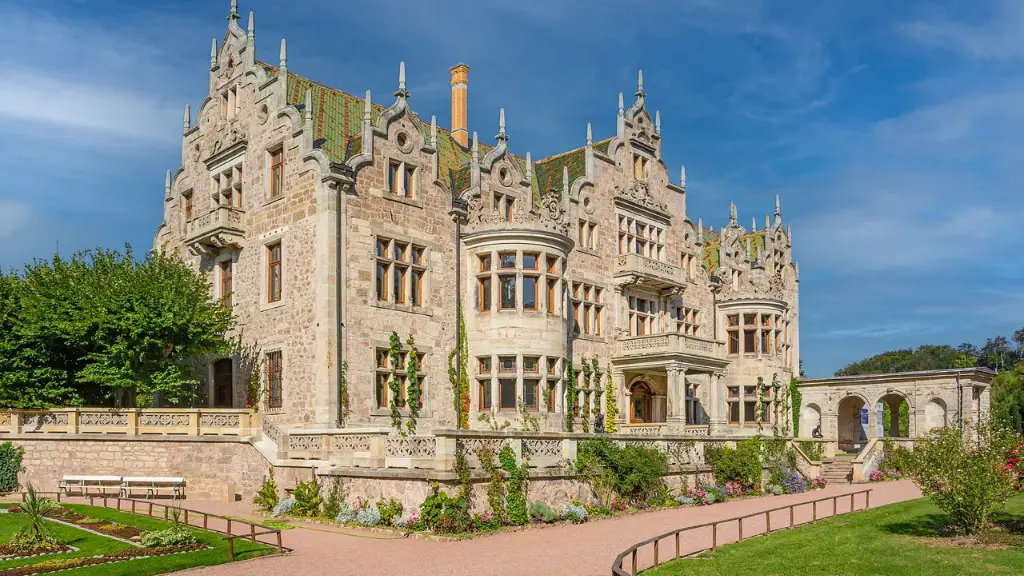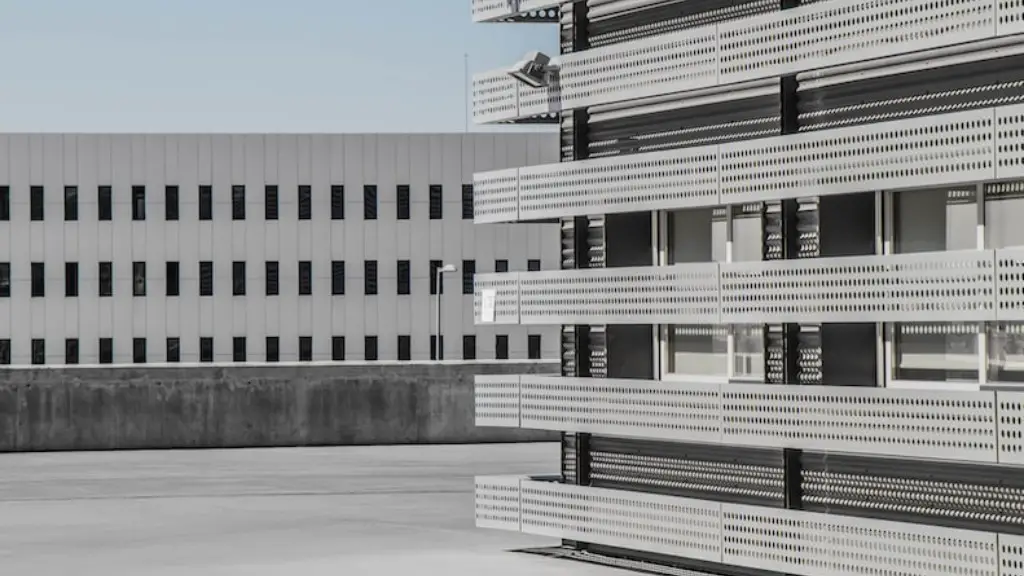What Is The Origin Of Architecture?
Architecture is a discipline where creativity is put to use to construct the physical world around us. It began as an ancient art form, the building systems that eventually became the foundations of the modern architectural industry being developed as far back as 2,000 BC, during the era of ancient Egypt. Architecture has been used not only to build structures for living, but also to communicate tangible ideas, such as a nation’s values or a spiritual belief system.
Architecture has evolved from the practical act of constructing dwellings and other buildings, to a more abstract practice of design and creative expression. In essence, architecture is the art and science of designing and constructing buildings, structures and systems. It involves the combination of elements such as scale, form, technology, materials, aesthetics and sustainability in order to create a safe and comfortable living environment.
The earliest forms of what we now call architecture date back to the Neolithic era (around 10,000 BC), when people constructed permanent settlements using simple construction methods. Over time, these methods were refined and improved as tools and materials advanced, and as architecture developed from being a practical necessity to an art form. One of the first and most influential architectural styles to emerge was that of the Egyptians, who believed that their purpose in life was to create a physical world closer to the spirit world. This spiritual connection is reflected in the grandeur and complex nature of their structures.
The Greeks were some of the first to start designing grandiose projects, such as their famous temples and theatres. These structures represented the peak of their architectural achievements and were often used as a form of cultural expression. Greek architecture, with its symmetry and balance, quickly spread throughout the Mediterranean and influenced the development of Roman architecture.
The Romans were pioneering builders who developed advanced construction techniques and revolutionized the way buildings were designed and constructed. They are responsible for many iconic pieces of architecture, including aqueducts, bridges, triumphal arches and amphitheatres, as well as for their use of arches and vaults. Their technology and techniques were adopted by many other cultures up until the modern day.
The Renaissance marked the beginning of a new, secular style of architecture, marking the emergence of the modern world. This period certainly saw an increase in the number of fine buildings and structures, but it was also a time of important structural and design advancements, such as the use of elevations, perspective drawing, volume building forms and a better understanding of the principles of statics.
The Role Of Materials In Architecture
Materials play a vital role in architecture, with its selection directly impacting both the design and performance of a structure. Different materials have differing characteristics and properties which determine their suitability for a given application, resulting in this being an essential consideration when it comes to designing buildings.
Stone and timber are two materials which have been in use since ancient times, when both were employed in the construction of temples, pyramids and other such constructions. Over the centuries, a tremendous range of construction materials have become available, such as metals, concrete and reinforced steel. These are cheaper and stronger than the natural materials of stone and wood, so are the favoured materials of the modern architect.
The modern designer is also able to select from a range of sustainable materials which are better for the environment. This includes materials such as bamboo, which is an extremely durable and fast growing plant which can be used to construct a variety of structures. Additionally, recycled materials such as aluminum or glass can be used to reduce the environmental impact of a construction project.
The use of advanced techniques, such as 3D printing, have also allowed architects to create sophisticated yet complex designs, utilizing a range of materials with different properties, such as ceramics, plastics and composites.
The Impact of Technology On Architecture
Technology has impacted the design and construction of buildings in fundamental ways. Innovations in the fields of engineering and construction, such as air conditioning and the development of artificial lighting and material patterns, have enabled architects to create magnificent architectural wonders around the planet.
The advent of the computer has changed the way architects design and construct buildings. CAD (Computer-Aided Design) and BIM (Building Information Modelling) software have enabled professionals to create elaborate and sophisticated designs, quickly and accurately. These programs have opened up a world of possibilities for the modern designer, providing them with a range of tools and features to create near-perfect designs.
Robotics and automation have also made their way into the world of architecture, with large-scale projects now being constructed with the help of drones, robots and other automated systems. Such automation has resulted in faster and more efficient building processes and reduces the number of human errors.
What is clear is that technology has made the process of designing and constructing buildings quicker, easier, safer and cheaper. While the incorporation of such technologies has pushed architectural design to its limits, it has also made such accomplishments more achievable than ever before.
The Role Of Sustainability In Architecture
The concept of sustainability has been increasingly applied to architecture in recent years, with designers focusing more on making buildings more eco-friendly, efficient and cost-effective. Such buildings often employ green materials, such as bamboo and other renewable resources, as well as energy-saving technology such as solar panels, insulation systems and rainwater harvesting.
Sustainability has become a major consideration in the world of architecture, as the use of unsuitable materials and construction techniques can have a huge environmental impact. As such, architects must now consider the long-term impact of their designs, such as the effect of their choice of materials and techniques on both the environment and inhabitants.
In addition to its huge potential to reduce pollution and conserve resources, sustainable architecture also has the potential to reduce the cost of construction projects. When considering the cost of materials, labour and construction, sustainable architectures is not only better for the environment but also more cost-effective in the long run.
As a result of the growing awareness of the importance of sustainability in architecture, many governments and organisations have begun encouraging the use of green technologies and techniques when constructing buildings. This is not only to benefit the environment, but also to ensure the health, safety and comfort of the inhabitants of these structures.
The Role Of Architects And Designers
Architects are the creative visionaries who bring buildings to life. They develop the overall design of a project, ensuring that the structure is feasible, efficient, aesthetically pleasing and up to code with all relevant regulations. Professionals must also be able to work with other industry professions, such as engineers and builders, in order to bring their design to life.
The practice of architecture is ever-changing, as new technologies, materials and regulations come into play. As such, architects must remain up to date with the latest developments and be able to adapt their designs accordingly. Additionally, they must be knowledgeable in both the history of architecture and changes and advancements in the industry.
In addition to architects and engineers, designers also play an important role in shaping the look and feel of buildings. They utilise their artistic talents to enhance the visual appeal of structures and to ensure the project reflects the client’s vision and personality. This includes selecting furniture, fixtures, textiles and other objects which enhance the aesthetic of the building.
The input of both architects and designers is vital when it comes to successfully creating a building which is both aesthetically pleasing and functional. Such collaboration between the two parties enables them to create a structure which meets all the necessary requirements, while being visually stunning and true to the spirit of the project.
The Impact Of Architecture On Society
Architecture, more than any other method of artistic expression, has the potential to transform societies and impact the lives of people around the world. Buildings are both a physical reflection of a society and an expression of their values and beliefs, and can be used to communicate and pass down cultural heritage and history.
The development and use of architecture is also closely tied to the economic structure of a society. For example, wealthy cities and countries often house numbers of distinctive and iconic buildings, while developing and rural areas often lack the funds to construct and maintain large-scale projects.
In addition, public architecture does more than just shape the look of a city; it also has an effect on the emotions and behaviours of its inhabitants. Buildings with unique and creative designs can inspire and motivate people, while practical and functional solutions can improve the safety and security of a city’s citizens.
It is evident that architecture has a much greater impact than just aesthetics and practicality. As time progresses, its potential for transforming and enhancing the lives of people will only become more apparent, as we strive for more efficient, inspiring and comfortable built environments.
The Impact Of Architecture On Culture
Apart from its obvious effect on the look and feel of a place, architecture can also influence a city’s culture. Buildings are closely associated with culture, as they are often designed to reflect the values, beliefs and aspirations of the people who inhabit them.
The culture of a place can be felt in the architecture, with everything from the materials used in a building to its design style reflecting an area’s cultural identity. Additionally, the emotional resonance of a building, such as its beauty or quirkiness, can speak volumes about the society it is situated in.
Architecture also has the potential to create harmony between different cultures. By embracing the values and beliefs of the various cultures in an area, it is possible to create structures which act as a bridge between them.
Finally, public architecture can also be used to communicate a nation’s values and identity. Buildings such as monuments or government buildings can be used as symbols of pride and patriotism, which can bring people together and help create a shared sense of identity.
The Future Of Architecture
Architecture will no doubt continue to advance and evolve as new technologies, materials and design trends emerge. We can expect to see more efficient, innovative and sustainable solutions in the future, which will result in buildings that are not only more aesthetically pleasing but also use fewer resources and have a minimal environmental impact.
3D printing is one such technology which is likely to revolutionize the design and construction processes. The ability to 3D print entire buildings or parts of buildings, such as wall components, will reduce the amount of time and resources required to build projects. Additionally, such a manufacturing process would offer near-infinite possibilities in terms of design.
Architecture is also beginning to embrace the potential of Artificial Intelligence, which promises to make the design and construction processes easier and more efficient. Such AI-assisted design tools would enable professionals to generate dozens of different design ideas with minimal effort, allowing them to develop the perfect solution with minimal trial and error.
It is clear that the future of architecture is an exciting one, and it will be interesting to see how such technologies and materials





